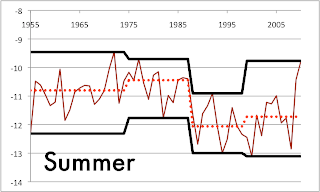Thursday, February 21, 2013
Four weeks of climate data (reboot):
Explaining the new method of data collection.
When I last reported on climate data on Tuesday, I was showing the stats for Antarctic Region 3. Like much of Antarctica, this region is sparsely covered with weather stations.
My first way of measuring the data showed this precipitous drop in average temperatures in all seasons in the late 1980s. A change of 8 degrees Celsius over such a short time span looked suspicious to me.
My original method was to take all the data from all the stations and spread it onto points of a 10 by 10 grid. The stations in this regions are marked by the red points.
What happened here is that the interior stations were not online until recently, and when they came in the average was skewed way down.
My new method still looks at all the data, but a grid point has to show consistency, data from at least 75% of the seasons in the time interval.
Following that rule, only two out of 100 grid points are consistent enough to make it to the final averages. This is going to get rid of data in some places, but it's necessary to do this to get more reliable results.
The blue crosses are the corners of the region. The boxes represent the grid points that are included in our regional average. This sparsely covered region is only represented by the stations at the edges of the Amery Ice Shelf.
Using the new method, we still see a modest cooling trend in the median and the low temperatures and a static pattern in the high temperatures. The thing that makes this more believable is that the changes are in the range of 1 to 2 degrees Celsius instead of nearly 8 degrees.
Another advantage of the new system is that I equalized the grid input. In the old system, very heavily covered input points could overwhelm the points with less coverage. Now, if a grid point makes the threshold of consistency, its data is treated equally will all other consistent grid points.
The data analysis begins again tomorrow.
Subscribe to:
Post Comments (Atom)





No comments:
Post a Comment